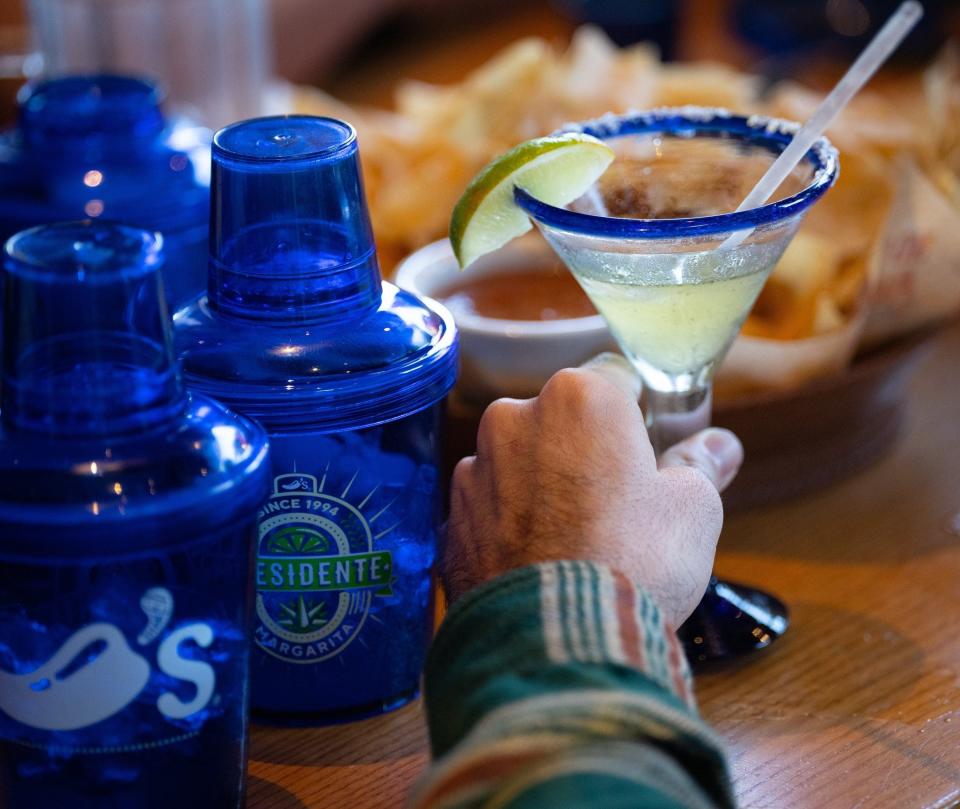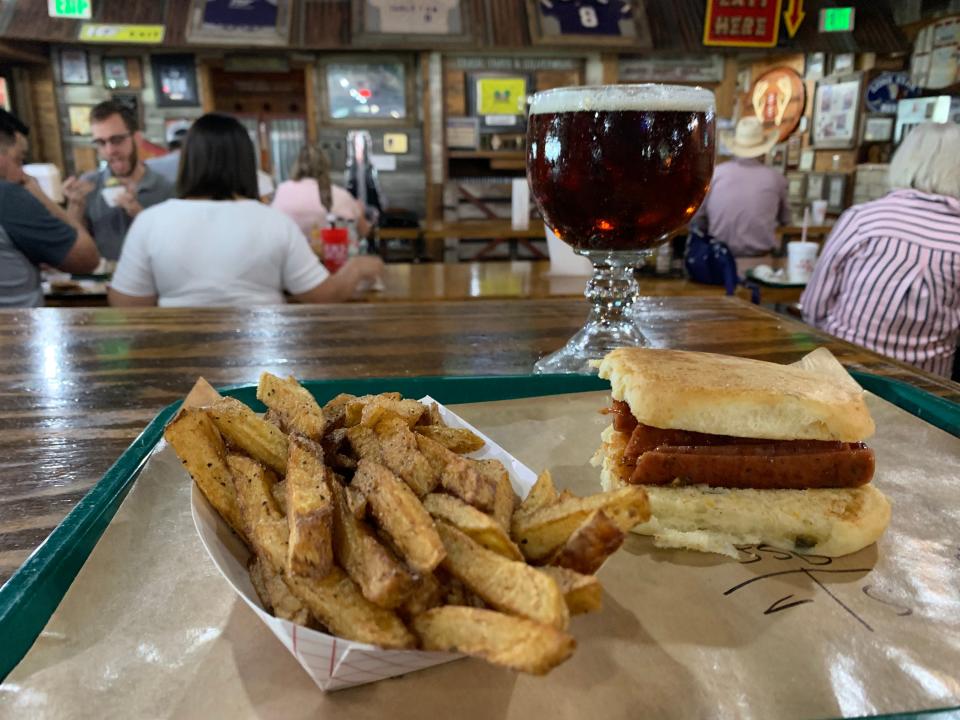Beer, margarita or iced tea: Which should be declared the official Texas state drink?
Texas has designated an official state stone (petrified palmwood), shell (lightning whelk) and grass (sideoats grama).
Among edibles, Texas has conferred the ultimate honor on a dish (chili), bread (pan de campo), fruit (Texas red grapefruit), nut (pecan), native pepper (chiltepin), "other pepper" (jalapeño), vegetable (Texas sweet onion) and snack (tortilla chips and salsa).
Two sweet bites, strudel and sopaipillas, share the title for state pastry. (I guess the kolache lobby slept in that day.)
What's missing here? Something to wash this feast down.
I hereby propose three beverages as official Texas state drinks.
In addition, I have added several runners-up to the end of the list.
Please nominate your own Texas libations at mbarnes@gannett.com.
Texas is just one big margaritaville
This choice is a no-brainer. Margaritas — frozen, on the rocks or straight-up — have been a staple of Texas culture for decades.

Cocktail historians trace the drink's origins back to a dozen different sources during the 1930s. Early versions of margaritas, sometimes with other names, were made with lime or lemon juice, Cointreau and tequila. The earliest claim that I've found credits Doña Bertha of Bertha's Bar in Taxco, Mexico, as the drink's creator.
It is easier to pinpoint the inventor of the frozen-margarita machine. The story is pure Texan. In 1974, entrepreneur Mariano Martinez, a Dallas native, adapted a Slurpee machine to make alluring concoctions that could be dispensed without the help of a bartender. The original machine is now housed at the Smithsonian Institution's National Museum of American History. (Side note: Around this same time, Jimmy Buffett started writing the song "Margaritaville" after day drinking at a tequila bar in Austin.)
More: Tastemakers: Readers share their favorite dishes from the Lone Star State
These days, margaritas come in a dizzying array of flavors, including avocado and sriracha-mango. I am a classic lime man myself. At times, I'll take a walk on the wild side and order the prickly pear or watermelon options. Still, any margarita should be mostly sour and only a tiny bit sweet.
Late in life, I have skipped the festive ring of salt, white or otherwise, on the rim of the glass.
More: Tastes like Texas? Tell us the dish(es) you think best rep our big giant state
Fresh ingredients, blended or stirred in generous amounts, are a must. No gritty mixes. Even a virgin margarita can invigorate the palate. But if you are looking for that zippy pleasure derived from distilled blue agave, avoid portions that come in stemmed glasses the size of goldfish bowls.
You will be disappointed.
Once at an otherwise pleasant — and no longer in business — restaurant on the Riverwalk in San Antonio, I was served one of those oversized, disheartening "margaritas." After a couple of sips, I ordered a shot of tequila because, as I politely informed the server, there was none in the drink.
He didn't blink an eye. He knew.
As for the distinctions among frozen, straight-up and on the rocks, like everything else, it comes down to a matter of taste. A good frozen margarita delivers a creamy texture that enhances the icy blend of ingredients. The constituent parts shine more brightly, however, when the drink is poured straight-up or on the rocks.
Lovers of both options can order a frozen margarita with a "floater" of top-shelf tequila on top. The scope of human ingenuity is limitless.

Going to war over sweet or unsweetened iced tea
Light and refreshing, a tall, beaded glass of iced tea goes well with a sandwich, salad, hamburger, enchiladas, barbecue or dim sum — you name it. I find myself craving the malty black tea taste, although I can switch to herbal alternatives if need be. These days, one can enjoy a plethora of hot-weather tea concoctions from around the world.
You can have lunch at almost any Texas restaurant and rest easy. If requested, your meal will be served with iced tea. In fact, it would be startling to be told than none was available.
More: Starring Texas: What you can learn about the state through its movies
Here comes trouble: The closer you come to our border with Louisiana, Oklahoma or Mexico, "sweet tea" dominates. Definitely preferred in the Deep South, it should never, in my opinion, be the only selection on the menu. Better yet, let people sweeten their own iced tea.
Let the brickbats begin!
While growing up in Texas, I sometimes bought a can of Lipton's iced tea at a grocery store, but it was almost always overly sweet and the metallic aftertaste never appealed to me.
I consider it sign of civilizational advance that Pure Leaf Iced Tea, unsweetened, is now available for purchase in easy-to-grip, recyclable plastic bottles at many Texas convenience stores.
The beers that made Texas famous
The consumption of beer can be traced back to the earliest days of the Texas Republic. Most of the suds were imported or home-brewed until German and Czech immigrants established small family breweries. Beer was prepared during the cold months and stored in cellars.
"William A. Menger's Western Brewery (1855–78), located on Alamo Square in San Antonio, is usually considered the first commercial Texas brewery," reports the Handbook of Texas Online. "By its last year of business in 1878, it was the largest operating brewery in Texas. In 1859, Menger also opened a very popular hotel next to his brewery. The Menger Hotel still contains the large cellar, constructed of three-foot-thick stone walls, that was used to chill the beer produced by the brewery."
The first large manufacturing concern in Fort Worth was a brewery. By the end of the 19th century, Pearl and Lone Star breweries competed for the largest output of the frothy stuff in San Antonio. In fact, most of the early breweries were located in places with large German or Czech populations, with the exceptions of El Paso and Nacogdoches.
The state's profitable breweries switched to other products during the Prohibition.
During the 1970s, Lone Star made a swipe at becoming the "National Beer of Texas." Its savvy advertising often featured armadillos, and in Austin the brand is still associated with the Armadillo World Headquarters and the concert posters from that era.
Founded in 1909 in Shiner, Spoetzl Brewery was among the few surviving makers of Texas-only brands in the late 20th century. When I arrived in Austin in 1984 to attend graduate school, Shiner Bock was all the rage. It was the first party keg to float. You would have thought it was already the official Texas beer, even though its statewide market share was microscopic.
St. Arnold's Brewery, which shipped its first keg from Houston in 1994, was among the first craft beer makers and brewpubs to become a media darling. Today, a Texas road tripper expects to find a brewpub in just about any courthouse square in the state, except in dry precincts.
Still, the vast majority of beer consumed in the state is made by huge commercial breweries owned by international conglomerates. Several popular Mexican brands, such as Corona and Modelo, belong to the Belgian behemoth Anheuser-Busch AB InBev. Their saturation marketing campaigns recall those once waged primarily by a few legacy American labels.
Still, beer remains very much at the heart of the Texas mythos. The list of country songs that mention beer, for instance, is without end.
"If you measured distance by the six-pack, then you grew up in Texas," reader Ed Dorn reminded me after reading my column on what makes a typical Texan. "The state outlawed driving while intoxicated (DWI) several decades ago, but it took the legislature a while longer to figure out the cause-effect relationship between drinking while driving and being drunk while driving.
"When I was attending UT back in the ‘60s, the distance from Austin to San Antonio was about half a six-pack. Then came the law against having open containers of alcohol in the passenger compartment. I have long suspected that pickup trucks had those little sliding glass windows between the cab and the truck bed to allow for quick disposal of an open can of beer."
Runners-up includes wine, water, liquor, coffee, soft drinks, fruit drinks
We didn't forget other Texas potables, potent or not.
More: Texas history: On second thought, make that 60 essential books about our state
Wine: In just a few decades, Central Texas has become one of the most attractive places in the U.S. for vineyards, wineries, tasting rooms and the travel culture associated with them. The state's viniculture revolution, however, started in West Texas and was originally associated with research at Texas Tech University. Those farmers still send many of their grapes to the Fredericksburg area to be turned into wine that is then tasted by and sold to locals, tourists and day-trippers. Along the way, growers have learned to specialize in hot-weather varietals such as Tempranillo and Viognier.
Water: Hydrate, hydrate, hydrate. In many places in Texas, plain tap water is delicious, whether derived from surface, underground or cistern sources. One exception taken from extensive personal experience: What comes out of the tap during our winter stays in Surfside Beach, Texas, is to be avoided. That is why nearly an entire aisle is devoted to bottled spring water at the H-E-B in nearby Lake Jackson.
Liquor: According to one whiskey historian, distilled spirits in Texas go back to 1680 at the Misión de Corpus Christi de San Antonio de la Ysleta del Sur near El Paso. Whiskey was the most popular hard beverage in Texas during the 19th century. But after being forced underground during Prohibition, the state's distilleries took decades to recover. Starting in the 1990s, modern liquor pioneers such as Austin's Tito's Handmade Vodka, Hye's Garrison Brothers Distillery, Dripping Springs' Treaty Oak Distilling and Waco's Balcones Distilling sparked a revival that continues to expand each year.
Coffee: No coffee is grown in Texas. (It requires a tropical, mountainous environment.) Yet coffee shops grew from stripped-down diners to ubiquitous necessities during the past 30 or so years. In Austin, trailblazers included Quackenbush's, Chicago House, Little City and Jo's Hot Coffee. Today there seems to be a coffee shop on every other corner in many Texas cities, and county courthouse squares have not been left out of this cultural phenomenon. If only you can nab a table from one of the studious laptop jockeys.
Soft drinks: While Texans, like most Southerners, call all sweet carbonated beverages "Cokes," Dr Pepper is intimately connected with the state's image. Visit the Dr Pepper Museum in Waco for its happy history. I would be remiss if I left out Big Red, also invented in Waco and closely associated with barbecue consumption in parts of the state.
Fruit drinks: Especially popular with the state's Mexican American population, these sweet beverages are perhaps best sampled fresh at fruterías — Mexican fruit bars with desserts, snacks, fruity beverages and comidas.
Michael Barnes writes about the people, places, culture and history of Austin and Texas. He can be reached at mbarnes@gannett.com. Sign up for the free weekly digital newsletter, Think, Texas, at statesman.com/newsletters, or at the newsletter page of your local USA Today Network paper.
This article originally appeared on Austin American-Statesman: Beer, margarita, iced tea could be the official Texas state drink

